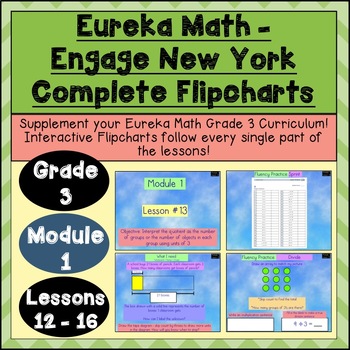Engage New York-3rd Grade Module 1-Lesson 12-16:Flipchart + Powerpoint
- Zip
Description
This file is an independent product and is not affiliated with, nor has it been authorized, sponsored, or otherwise approved by Great Minds PBC. Eureka Math® is a trademark of the Great Minds PBC.
In addition to the .flipchart file, I have converted the flipchart to Powerpoint. Included in this item is both a powerpoint file AND flipchart file! The flipchart file is interactive, the powerpoint is not.
This is a completely interactive flipchart resource for lessons 12-16 of Eureka Math (which is also Engage New York). (It is in ".flipchart" file format).
Included is also a powerpoint file with the same slides.
This product is completely teacher ready, and has every single part of each lesson in a easy to use, engaging way. It includes objectives for each lesson, fluency, application problems, concept development, problem sets (to go over with students for the debrief section), and exit tickets.
The flipcharts include pictures, teacher questions to pose to students (that Eureka tells teachers to ask in the lessons), and sections to write on the flipcharts. After having these flipcharts, there is no more need to print out the manual for each lesson! This product is completely editable if you would like to move things around. Flipcharts can also be easily printed and turned into anchor charts for the classroom!
In this product, I have also included the font that I used to make the format. If you open up the flipchart, the formatting might be a little off - but if you install the font beforehand, it will work perfectly!
To install font:
1. Double click the font (.ttf file)
2. Click install font!
Very easy!
If you are interested in the rest of the 3rd grade Eureka Math Curriculum as flipcharts - find the rest of the Modules + Lessons below!
Module 1 - All Lessons Bundle
Module 2 - Lessons 1 - 6
Module 4 - Lessons 12 - 16
Module 4 - All Lessons Bundle
Module 5 - Lessons 1 - 6
Module 5 - Lessons 17 - 21
Module 5 - Lessons 22 - 30
Module 6 - Lessons 1 - 4
Module 6 - Lessons 5 - 9





